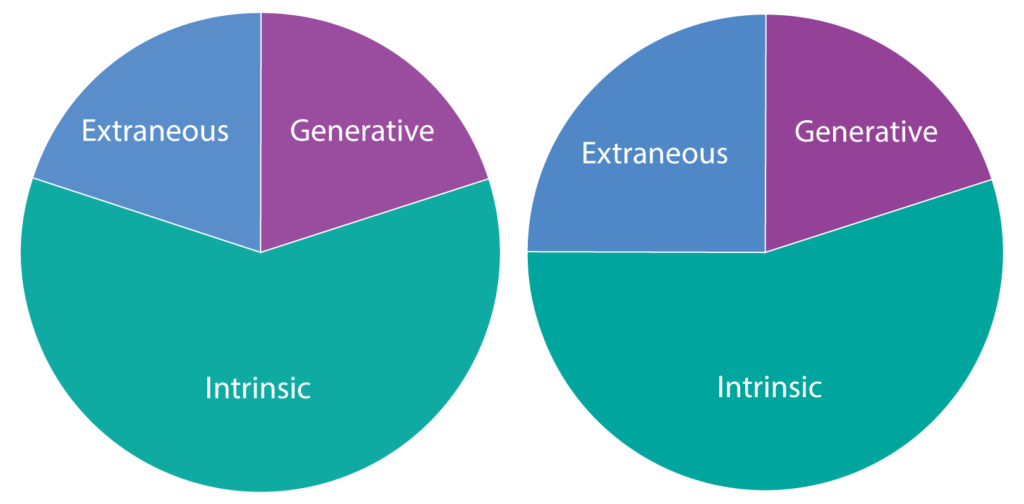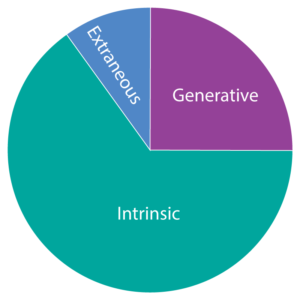When you walk into a classroom, you embody everything about your course for your students. You welcome them, explain the course structure, describe the relevance of content, and answer questions about expectations. When you move to an online teaching environment, that communication is mediated by technology (Major, 2015). In other words, what passes naturally and directly from you to your students in a classroom now passes from you into a computer and from the computer to your students. The choices you make about how to organize and label the components of your online course can impact students’ learning experiences.
What does the research say?
We have known for some time now that our capacity for active cognitive processing, called working memory, is limited (Baddeley, 1999). Cognitive Load Theory identifies three different types of cognitive load–intrinsic, extraneous, and generative (Sweller, Merrienboer, & Paas, 1998). Think of an individual’s cognitive capacity as a pie with three pieces. If one piece grows in size, another must shrink.

Intrinsic load is the cognitive work your students need to engage in in order to process your course material. Extraneous load is “extra” processing that occurs when materials are hard to find or instructions are difficult to understand. Focus on reducing your students’ extraneous processing as much as possible to free up their cognitive resources for learning.
What is generative processing? Generative processing is derived from elements that help students make sense of material and process it into long-term memory or more complex knowledge structures. Elements that invoke generative processing actually reduce the intrinsic demands of a learning task.

What are some practical implications of Cognitive Load Theory for structuring an online course?
CATLR Tips
- Use consistent structure and naming conventions for the types of assignments that recur from week to week (or unit to unit). Students will quickly become accustomed to the course structure and will not have to spend cognitive resources figuring out what to do each week.
- Organize your course to communicate the flow of work you would like students to follow. Organize folders of content chronologically, and if you want students to follow a certain sequence of activities, list them in order.
- Make frequently used resources easy to find. If you have instructions for major assignments or resources that will be used throughout the course, keep these in a section at the main menu level, rather than in a weekly folder where students will have to hunt for them.
- Choose titles for your weekly/unit sections that will help students understand the structure of your course. (This is an example of using generative processing.) Is your course built around central questions? A series of themes? A theoretical framework? Use your naming conventions to communicate the structure of what you want students to learn.
References
Baddeley, A. D. (1999). Human memory. Boston, MA: Allyn & Bacon.
Major, C. (2015). Teaching online: A guide to theory, research and practice. Baltimore, MD: Johns Hopkins University Press.
Sweller, J., Merrienboer, J. J. G. van, & Paas, F. G. W. C. (1998). Cognitive architecture and instructional design. Educational Psychology Review, 10(3), 251–296. doi:10.1023/A:1022193728205
